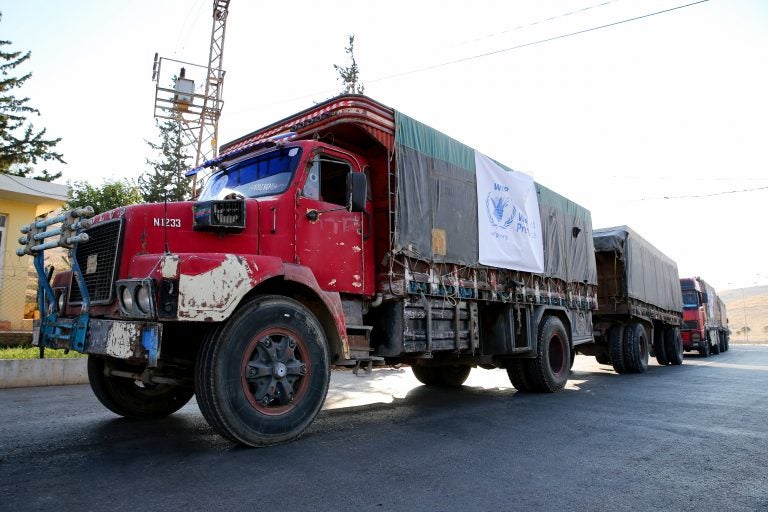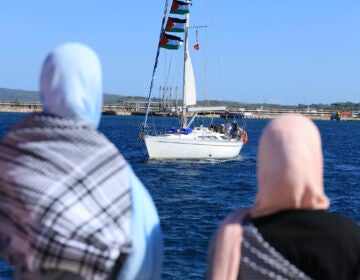Have a cool idea to help end world hunger? Pitch it to the U.N.

A World Food Programme convoy carries humanitarian aid to Aleppo, Syria. Getting food into conflict zones is a major hurdle — and a topic of discussion at the WFP's Innovation Accelerator. (Cem Genco/Anadolu Agency/Getty Images)
Let’s figure out how to end hunger forever. And do it fast.
That’s the lofty goal of the World Food Programme’s Innovation Accelerator, a two-year-old venture inspired by the startup scene. It’s gathering an arsenal of ideas to help fight hunger — both by brainstorming internally and supporting outside entrepreneurs — to test out in the real world as quickly as possible.
There are more than two dozen projects already underway. Some are still in early stages of development, such as an artificial intelligence program that can analyze images collected by drones after a natural disaster. The plan is to train it to automatically flag potential problems, like a collapsed bridge. Other concepts are further along, such as Dalili, a smartphone app designed to help needy families who buy food at shops that have been contracted by WFP to provide food assistance. The app lists what’s available where and for what price, so customers can better plan out their grocery shopping. A pilot program was launched in two cities in Lebanon last November, and it’s now gone nationwide.
This progress is monitored from the Accelerator’s modern offices in downtown Munich, which sit atop the headquarters of Rischart, one of Germany’s best-known bakeries. So, fittingly, the scent of fresh bread and pastries wafts up each morning to greet the 25-person staff, a mix of folks dedicated to project management, fundraising, partnerships and communications.
Near the entrance, there’s a food computer, which is essentially a real miniature garden controlled by sensors. It’s testing how variables, like temperature and light, can be adjusted to yield the best possible crops in adverse conditions. Several more of these gizmos have been installed at Jordan’s Azraq refugee camp, home to more than 30,000 Syrians. For the moment, at least, the cucumbers inside this unit appear to be thriving.
Most of the activity takes place down the hall around one long table that’s set up for “hot desking,” since so many employees cycle through between trips into the field. (There are also a few staffers permanently stationed in East Africa and the Middle East.)
“This is a great sandbox to test things,” says former communications consultant Alex Sloan, who helped get the Accelerator off the ground. “But ultimately, you need to get closer.”
Sometimes, though, you need distance, too.
The Accelerator is more than 500 miles away from the WFP’s headquarters in Rome, which gives it the freedom to operate differently, explains partnerships manager Julia Bacher. She has been with the U.N. agency for 13 years, handling logistics and response to crises around the world.
Although the Accelerator is actively in search of additional financial support, from both the public and private sectors, it’s now funded entirely by German sources (the German Ministry for Economic Cooperation and Development, the German Federal Foreign Office and the State of Bavaria). So that’s one of the main reasons it’s located in the Bavarian capital.
“And it turns out Germans are actually good at engineering,” deadpans Sam Ng, who founded and sold multiple technology companies back in his native New Zealand before joining the WFP Innovation Accelerator team. “We can have conversations about robots landing on asteroids,” he adds, noting that local partners include the German Aerospace Center (DLR) — basically Germany’s NASA.
The Accelerator prides itself on turning talk into action. Take, for example, a role-playing exercise Ng participated in based on a dire situation in Eastern Aleppo, Syria, in late 2016 — when it was nearly impossible to get food into the area. He was assigned the part of a truck driver hauling supplies to distribute to starving people. And then, he was stopped at a security checkpoint by a armed and menacing figure.
“At a certain point, I’m freaking out,” Ng says. If he were really behind the wheel, he’d know what he’d say: “No, you’re not paying me enough to keep going.”
Of course, the food has to get through somehow, which is why Ng and his colleagues started toying with alternatives.
One promising concept the group has considered is self-driving vehicles, which would take human jitters out of the equation. The downside is there would be other added complications, Ng explains. Say the truck gets to that checkpoint without anyone on board, but the menacing guy is still there. So that needs to factor into how the truck is designed and what mechanisms exist for communication, he says. Plus, there’s the issue of staying on roads that aren’t conveniently marked with lane lines — and may be filled with debris, wandering goats or even landmines.
And while plenty of companies have been pursuing self-driving technology, their typical test conditions are nothing like what the WFP faces, Bacher says. If a map of some of these places even exists, it may not be reliable. “After natural disasters, roads disappear,” she adds.
Rather than simply sit around and ponder these problems, the Accelerator dispatched a couple of retrofitted trucks to Uganda to gather video data last year. The results so far? It needs “a lot more research,” Ng says.
But land, he adds, is just one option. There’s also air. With self-driving trucks on the backburner, the Accelerator’s busy with another idea: using drones to deliver supplies from the sky.
Although airdrops have traditionally been expensive and risky, they’re in greater demand because of climate change and conflicts. So the Accelerator has partnered with DLR and Wings for Aid, a Dutch foundation, to test using UAVs (that’s unmanned aerial vehicles) to release specially designed cardboard boxes.
Side flaps open up and act kind of like a parachute on the descent, allowing the box and its contents to land safely. A team in the Dominican Republic this summer completed several successful test flights, including one delivering about 44 pounds of supplies across a body of water in difficult weather conditions.
What makes that project particularly important to the Accelerator’s mission is that the idea came from Wings for Aid, not from within WFP. To bring in varied voices, the Accelerator welcomes applications from anyone looking to collaborate. The tantalizing sales pitch: If you have a bright idea, we’ll give you up to $100,000 in funding. (The deadline for the next call for applications is Sept. 24.) Selected entrepreneurs maintain control of their innovations while tapping into WFP’s resources, including knowledgeable staff and access to people and locations around the globe.
In 2017, the Accelerator received more than 1,160 applications — from both external and internal teams — and selected 29 to participate in one of its boot camps. Those week-long programs are a crash-course in understanding what the Accelerator does. Invitees repeatedly refine and pitch their ideas, a process that requires every available blackboard, easel, whiteboard and Post-it note in sight. Markers run out of ink, and some people get so overly enthusiastic that they write on the walls. Boot camp wraps up with a “Shark Tank”-style presentation to a panel of judges. “We throw darts at the idea,” Ng says.
Entrepreneurs who pass the test are then accepted to the “Sprint” program. They’re paired with an Accelerator project manager, and they work rapidly together to create a minimum viable product, or MVP, that they can test in the field.
If it’s a hit, they try to improve and expand on the prototype, which can be tricky since the Accelerator doesn’t actually have many independent resources to scale projects up.
“We’re de-risking experimental ideas and then finding better stakeholders,” Ng explains, in perfect startup wonk-ese. What he means is that they’re looking for partners with cash — and a little imagination.
Take, for example, serial entrepreneur Carlo Almendral, who is a founding member of the WFP’s Innovation Advisory Council. He’s put forth his own funding to help the expansion of “Tech for Food,” an Accelerator project that offers digital literacy training courses to vulnerable young men and women in Lebanon and Iraq, teaching them skills such as data cleaning, photo editing and web design.
“Aside from assistance, it gives them a future,” Ng says, because with access to an internet connection, all sorts of remote employment opportunities open up. Since 2016, Tech for Food has trained 1,000 students, and that’s just the beginning. WFP’s goal is to reach 100,000 in the next five years, and bring these courses to new parts of the world.
This September, it’s launching in Kenya and Nairobi.
So, it’s possible the biggest innovation of all, the one that will make sure no one goes hungry ever again, could come from a untraditional place — maybe even a refugee camp.
Vicky Hallett is a freelance writer based in Florence, Italy.
9(MDAzMzI1ODY3MDEyMzkzOTE3NjIxNDg3MQ001))




